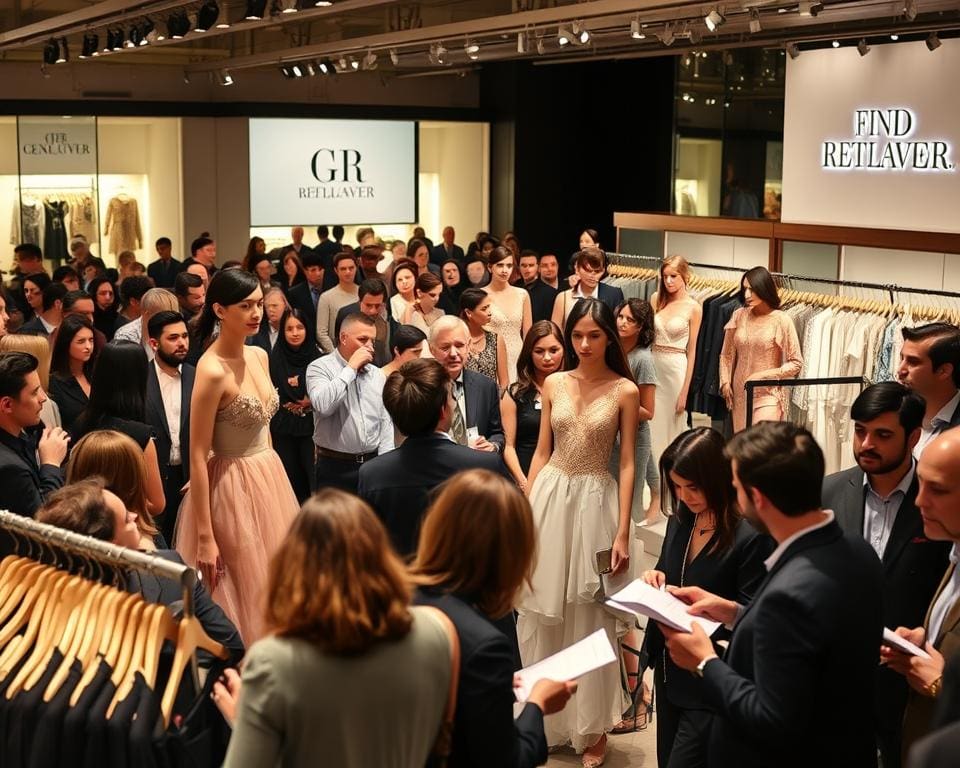In the ever-evolving world of style, understanding what is fashion buying and merchandising is vital for aspiring professionals and fashion enthusiasts alike. Fashion buying involves selecting and purchasing garments and accessories that resonate with contemporary market trends and consumer needs. On the other hand, fashion merchandising revolves around presenting these products in an engaging manner, utilising clever visual displays and innovative marketing strategies.
The synergy between fashion buying and merchandising plays a crucial role in retail operations, significantly influencing consumer psychology and purchasing behaviour. Insights from reputable sources, including the British Fashion Council, highlight the importance of these fields in a competitive market, where the fusion of trend awareness and strategic presentation can lead to retail success.
Understanding Fashion Buying
Grasping the concept of fashion buying is crucial to appreciate the significant responsibilities that buyers hold within the fashion industry. Fashion buyers wield considerable influence, as their decisions shape the collections consumers see in retail stores. Their role involves not only recognising emerging trends but also selecting the right merchandise that resonates with current market demands. Effective inventory management and fostering strong supplier relationships further contribute to their success in retail buying.
Definition and Role in the Fashion Industry
Fashion buying sits at the heart of the fashion industry, acting as the bridge between design and consumer. Buyers assess market trends, consumer preferences, and pricing strategies to curate product assortments that appeal to targeted demographics. This process requires a blend of analytical prowess and creativity, enabling fashion buyers to anticipate what styles will resonate with customers.
Key Skills Required for Fashion Buyers
A successful career in fashion buying demands a variety of key skills, including:
- Negotiation abilities: Essential for securing the best deals with suppliers.
- Keen eye for detail: Important for selecting high-quality merchandise.
- Understanding of consumer behaviour: Helps in predicting trends and preferences.
- Adaptability: Vital for adjusting strategies in response to shifting market conditions.
- Strong communication skills: Necessary for collaboration across departments and alignment with marketing efforts.

What Is Fashion Buying And Merchandising
The realms of fashion buying and merchandising operate in close tandem, forming a vital synergy that defines retail management strategies. Buyers curate product selections that resonate with consumer desires, while merchandisers orchestrate visual displays to enhance those selections. This interplay significantly influences overall sales performance and brand perception.
Interplay Between Buying and Merchandising
In the landscape of retail management, the connection between fashion buying and merchandising becomes evident. Buyers must consciously consider how their choices will reflect and shape merchandising strategies. Merchandising involves not only the presentation of products but also the promotional tactics employed to entice customers. With a keen understanding of what sells best, buyers can enhance their selections in ways that align with the merchandising team’s strategies. This cohesive collaboration fosters a climate where customer engagement flourishes, ultimately leading to increased loyalty.
Importance in Retail Management
Effective retail management hinges on the dynamic relationship between fashion buying and merchandising. When both functions align seamlessly, it leads to enhanced brand identity and improved customer experience. Retailers such as ASOS and Boohoo highlight the advantages of this integration, demonstrating how fluid communication between buyers and merchandisers can streamline operations. Insights gained from liquidity management and inventory turnover reveal crucial data needed for sustaining profitability. A well-executed approach in fashion merchandising not only boosts sales figures but strengthens the entire retail operation.
The Process of Merchandise Planning
Merchandise planning serves as a cornerstone in the fashion buying process. It involves a detailed and systematic approach to ensure that the right products are available at the right time and in the right quantities. A successful strategy in merchandise planning not only anticipates consumer demand but also aligns with brand goals and market trends.
Steps Involved in Merchandise Planning
The journey of merchandise planning typically comprises several crucial steps, including:
- Analyzing historical data: This step lays the foundation by assessing past sales patterns and inventory performance.
- Predicting consumer demand: Understanding market dynamics and consumer preferences informs product selection.
- Developing assortment plans: This involves curating a balanced mix of products to appeal to target consumers.
- Managing inventory: Accurate stock levels are critical for meeting demand without overstocking.
- Timely product delivery: Ensuring products reach stores or online platforms when they are needed maximises sales opportunities.
Tools and Software for Merchandise Planning
Incorporating advanced tools significantly enhances the effectiveness of merchandise planning in fashion buying. Software such as Retail Pro and TradeGecko aid retailers in managing their stock levels efficiently and tracking sales trends accurately. The integration of these tools allows buyers to make informed decisions based on real-time data analysis, fostering agility in a fast-paced market. Resources like Shopify highlight the increasing importance of web-based solutions that empower users to adapt swiftly to evolving consumer demands.
Trend Forecasting in Fashion Buying
In the ever-evolving landscape of fashion buying, trend forecasting stands as a pivotal element. It allows buyers to anticipate future styles and consumer preferences, enabling them to remain competitive in the dynamic market. Identifying trends involves a blend of creativity and analytical skills, turning data into actionable insights.
How Trends Are Identified
Fashion buyers tap into multiple sources to discern emerging trends. These include:
- Fashion shows showcasing the latest collections
- Social media platforms where influencers share styles
- Market research reports that analyse consumer interests
Analysts leverage data analytics tools to interpret information, connecting the dots between aesthetic developments and consumer behaviour. Recognising patterns in spending and style preferences helps buyers predict what will resonate with their clientele.
The Role of Consumer Behaviour in Trend Forecasting
Consumer behaviour profoundly influences trend forecasting. Understanding the motivations and desires of the target audience enables buyers to select products that align with market demand. Research firms like WGSN provide invaluable insights, revealing the psyche of consumers through comprehensive studies. This depth of knowledge allows fashion buyers to curate selections that appeal to evolving tastes.
The intersection of in-depth market analysis and consumer insights creates a fertile ground for innovative product offerings, essential for thriving in modern fashion buying.
Fashion Retailing Strategies
Fashion retailing thrives on the application of innovative sales techniques that resonate with distinct consumer segments. The rise of technology has opened new channels for engagement, encouraging retailers to adapt their approach in a rapidly evolving market. Understanding the nuances between bespoke production and mass production models can significantly influence a retailer’s success.
Sales Techniques in Fashion Retailing
The array of sales techniques utilised in fashion retailing encompasses various strategies designed to attract and retain customers. Personal selling remains a powerful tool, allowing for tailored interactions that build relationships. The incorporation of online platforms ensures that retailers reach digital-savvy shoppers effectively. Notably, social media marketing has transformed client engagement, allowing brands to showcase their latest offerings while fostering a sense of community.
Bespoke vs. Mass Production Models
The distinction between bespoke production and mass production models demonstrates contrasting methodologies in meeting consumer needs. Bespoke fashion provides personalised experiences, catering to niche markets with unique tastes and preferences. This level of customisation fosters loyalty and encourages repeat business. In contrast, mass production models drive efficiency through high-volume sales, appealing to a broader audience. Renowned brands like Savile Row’s tailor shops embody the bespoke approach, while popular high street retailers exemplify mass appeal.
The Future of Fashion Buying and Merchandising
The landscape of fashion buying and merchandising is on the brink of a significant transformation, shaped by rapid advancements in technology and evolving consumer expectations. In an era where sustainable practices are no longer optional but essential, consumers are demanding that brands commit to ethical sourcing and transparency. A shift towards sustainability is becoming a crucial pillar in effective retail management, where conscious consumerism is steering brand strategies.
With the integration of artificial intelligence and big data analytics, fashion buyers now possess powerful tools to anticipate trends and consumer needs with unparalleled precision. These technological advancements allow for more informed decision-making, ensuring that fashion merchandising aligns closely with what customers truly desire. Retailers who leverage these innovations will not only meet expectations but also create memorable shopping experiences that foster loyalty and trust.
As the industry evolves, traditional retail models must adapt to encompass omnichannel approaches, blending online and offline experiences seamlessly. Prominent brands like Zara and H&M exemplify agility in their operations, responding swiftly to market trends and consumer insights. This readiness to pivot will be imperative for retailers aspiring to remain relevant in a competitive marketplace, underscoring that the future of fashion buying and merchandising lies in embracing change and prioritising consumer-centric strategies.









